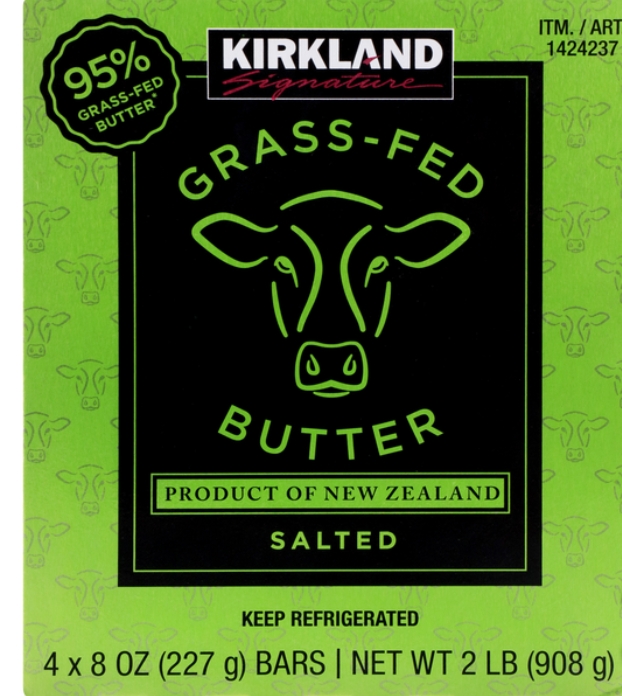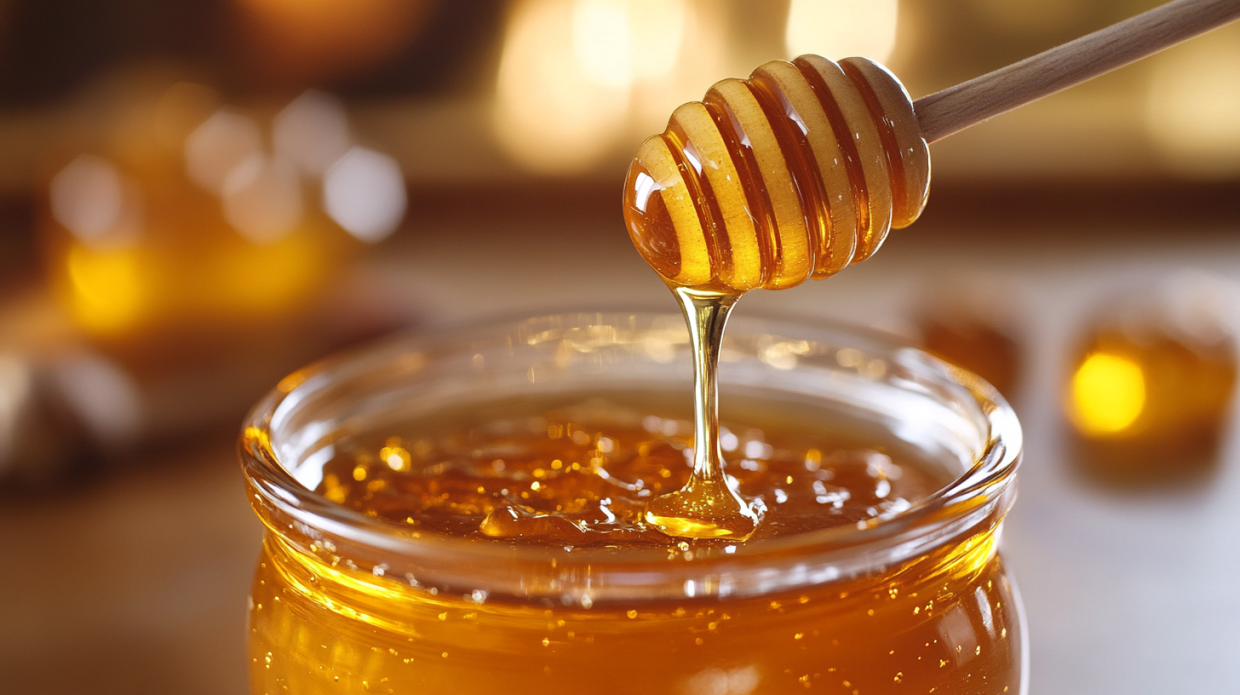
Kirkland Signature Grass-Fed Butter, Salted, 8 oz, 4 ct
- Grass-Fed Butter
- Salted
- Keep refrigerated
- 8 oz bar
- 4 ct
From Farm to Table: The Untold Story of Costco’s Premium Butter Option
In the world of culinary ingredients, few items spark as much passionate debate as butter. The rich, creamy foundation of countless dishes has evolved from a simple staple to a sophisticated ingredient with nuanced flavors, nutritional considerations, and ethical implications. Among the contenders vying for a spot in your refrigerator, Kirkland Grass Fed Butter has emerged as a game-changer for home cooks seeking quality without breaking the bank.
As someone who has experimented with virtually every butter variety available on the market, I’ve developed a particular appreciation for what sets truly exceptional butter apart. The moment I first unwrapped that distinctive silver foil of Kirkland’s offering, I knew this warranted deeper exploration. What makes this Costco exclusive so special? Is it truly worth the switch from conventional options? Let’s dive into everything you need to know about this increasingly popular kitchen essential.
The Fundamentals: What Actually Goes Into Kirkland Grass Fed Butter?
The ingredients list on Kirkland Grass Fed Butter is refreshingly simple. Unlike many commercial butters that contain additives, preservatives, or artificial colors, Kirkland’s version contains just two ingredients when you opt for the unsalted variety: pasteurized cream from grass-fed cows and natural flavoring. The salted version adds salt to this minimal list, creating a clean profile that butter purists appreciate.
This simplicity isn’t just appealing to minimalists—it speaks to a broader philosophy about food production. The emphasis on grass-fed cream means the cows producing this butter consume a diet primarily consisting of grass rather than grain. This distinction fundamentally alters the nutritional composition of the final product and connects to traditional farming practices that preceded industrial agriculture.
“I switched to Kirkland Grass Fed Butter after reading about the differences in fatty acid profiles between grass-fed and grain-fed dairy,” explains nutritionist Sarah Jennings. “What I initially considered a small dietary change has actually made a noticeable difference in how I feel after consuming dairy products.”
The Organic Question: Natural, But Is It Certified?
One common point of confusion surrounds Kirkland Grass Fed Butter’s organic status. While the product is made from the cream of grass-fed cows, it is not officially certified organic. This distinction matters for consumers who prioritize organic certification in their purchasing decisions.
For a product to carry the USDA Organic seal, it must meet specific criteria regarding pesticide use, animal raising practices, and processing methods. While Kirkland’s grass-fed butter aligns with many organic principles—particularly regarding animal diet—it doesn’t carry the official certification that would require adherence to all organic standards.
Does this make it inferior to organic options? Not necessarily. Many farmers implement numerous sustainable and natural farming practices without pursuing organic certification due to the considerable expense and administrative requirements involved in the certification process. The grass-fed designation itself indicates a more natural approach to dairy production than conventional methods, even without the organic label.
Origin Story: Where Does Kirkland Grass Fed Butter Come From?
Tracing the origins of Kirkland’s grass-fed butter reveals an interesting global connection. The product is sourced from New Zealand, a country renowned for its dairy industry and commitment to grass-feeding practices. New Zealand’s temperate climate allows for year-round grazing, creating ideal conditions for consistent grass-fed dairy production.
This sourcing decision by Costco leverages New Zealand’s established expertise in grass-fed dairy while providing American consumers access to international quality standards. The country’s strict agricultural regulations and emphasis on sustainable farming practices add another layer of quality assurance to the product.
New Zealand’s dairy industry has built its reputation on free-range, grass-fed livestock management that aligns with both traditional farming wisdom and contemporary environmental considerations. The cows producing cream for Kirkland’s butter spend significantly more time outdoors grazing on natural pastures than many of their counterparts in more industrialized dairy operations.
Value Proposition: Analyzing the Cost Factor
One of the most compelling aspects of Kirkland Grass Fed Butter is its price point. At approximately $8-10 for four 8-ounce packages (totaling 2 pounds), it offers significant savings compared to other premium grass-fed butter brands. This pricing strategy makes high-quality butter accessible to a broader range of consumers who might otherwise find premium butter options prohibitively expensive.
When compared ounce-for-ounce with other grass-fed options like Kerrygold or Organic Valley, Kirkland typically offers savings of 20-30% while maintaining comparable quality. This value proposition exemplifies Costco’s overall approach to private label products—delivering premium quality at more accessible price points by leveraging their enormous purchasing power and streamlined distribution.
For budget-conscious home cooks who don’t want to compromise on ingredients, this cost efficiency makes it possible to incorporate higher-quality butter into everyday cooking rather than reserving it only for special occasions.
Quality Comparison: Grass-Fed vs. Conventional Butter
The differences between grass-fed and conventional butter extend beyond marketing terminology. Grass-fed butter typically contains higher levels of beneficial nutrients like omega-3 fatty acids, conjugated linoleic acid (CLA), vitamin K2, and beta-carotene than its conventional counterparts. These nutritional differences stem directly from the cows’ diet—grass naturally contains compounds that ultimately transfer to the milk and butter.
Visually, Kirkland Grass Fed Butter exhibits a more pronounced yellow hue compared to conventional butter, particularly noticeable during certain seasons. This natural coloration comes from beta-carotene in the grass consumed by the cows, not from artificial coloring agents used in some commercial butters.
Texturally, many culinary professionals note that grass-fed butters like Kirkland’s tend to have a softer consistency at room temperature and a lower melting point. This characteristic makes them spread more easily on bread and incorporate more readily into certain recipes, particularly those calling for room-temperature butter.
Salt Content: Options for Every Palate
Kirkland offers both salted and unsalted versions of their grass-fed butter, catering to different culinary needs and taste preferences. The salted variety contains approximately 90mg of sodium per tablespoon, which places it in the moderate range compared to other salted butters on the market.
The salt used in Kirkland’s butter serves both as a flavor enhancer and as a natural preservative, potentially extending the product’s shelf life slightly compared to its unsalted counterpart. For everyday toast, general cooking, and many baking applications, the salted version provides convenience and ready-to-use flavor.
The unsalted version gives cooks precise control over sodium content in recipes, making it particularly valuable for baking where salt quantities are carefully calibrated, or for those following sodium-restricted diets. Having both options available in the same quality and price range provides valuable flexibility for diverse cooking needs.
Nutritional Profile: Breaking Down the Numbers
A detailed look at Kirkland Grass Fed Butter’s nutritional information reveals both the expected butter basics and some distinctive grass-fed advantages. Each tablespoon (14g) contains approximately:
- Calories: 100-110
- Total Fat: 11-12g
- Saturated Fat: 7-8g
- Trans Fat: 0g
- Cholesterol: 30mg
- Sodium: 0mg (unsalted) or 90mg (salted)
- Carbohydrates: 0g
- Protein: <1g
Beyond these standard metrics, the grass-fed nature of the product contributes to its enhanced nutritional profile. Research suggests grass-fed butter contains up to 500% more conjugated linoleic acid (CLA) than conventional butter, along with significantly higher levels of fat-soluble vitamins like A, D, E, and K2.
The omega-3 to omega-6 ratio in grass-fed butter tends to be more balanced than in conventional dairy products, potentially contributing to its anti-inflammatory properties. While butter remains a calorie-dense food that should be consumed in moderation, these nutritional advantages give Kirkland’s grass-fed option a meaningful edge over conventional alternatives.
Keto Compatibility: A Perfect Match?
The rising popularity of ketogenic diets has created increased demand for high-quality fats, and Kirkland Grass Fed Butter has become a staple for many keto adherents. Its high fat content, absence of carbohydrates, and enhanced nutritional profile make it an ideal fit for ketogenic dietary patterns that emphasize healthy fat consumption while strictly limiting carbohydrates.
“Kirkland’s grass-fed butter has been a cornerstone of my ketogenic lifestyle for three years now,” shares Michael Torres, a keto advocate and nutrition blogger. “The combination of quality and affordability makes it sustainable for long-term adherence to a high-fat dietary approach.”
Many keto followers incorporate this butter into “fat bombs,” bulletproof coffee, and various high-fat cooking applications. The enhanced CLA content and improved fatty acid profile of grass-fed butter align particularly well with the metabolic goals of ketogenic eating plans focused on quality fat sources rather than simply meeting macronutrient ratios.
Brand Comparison: Kirkland vs. Kerrygold
In the premium butter category, Kerrygold has long been considered the benchmark against which other grass-fed options are measured. How does Kirkland’s version compare to this established favorite?
In terms of taste, both butters offer rich, complex flavors that surpass typical commercial options, though some butter connoisseurs detect subtle differences. Kerrygold tends toward a slightly more pronounced “grassy” flavor profile, while Kirkland offers a clean, creamy taste that some find more versatile across different culinary applications.
Texturally, they’re comparable, with both exhibiting the characteristic softness and lower melting point associated with grass-fed butter. Color variations exist between the brands, with Kerrygold often displaying a deeper golden hue, particularly in certain seasons.
The most significant difference remains price, with Kirkland typically costing 20-30% less than Kerrygold while maintaining comparable quality standards. This value proposition has convinced many loyal Kerrygold users to make the switch for everyday use, sometimes reserving the Irish butter for special occasions or particular applications where its distinctive flavor profile is specifically desired.
Baking Performance: From Cookies to Croissants
For dedicated bakers, butter quality can make or break complex recipes. Kirkland Grass Fed Butter performs exceptionally well across various baking applications, from everyday cookies to more technically demanding pastries like croissants and puff pastry.
The slightly lower melting point of grass-fed butter creates particularly tender results in many baked goods. For laminated doughs like croissants, this characteristic can be managed by adjusting chilling times slightly, resulting in exceptional flakiness when properly handled.
Professional baker Elaine Chen notes, “I’ve found Kirkland’s grass-fed butter creates more tender crumb in butter-forward recipes like shortbread and pound cake. The clean flavor allows other ingredients like vanilla and citrus to shine without competing undertones you sometimes get with conventional butter.”
For recipes where butter flavor is prominent—think shortbread, butter cookies, or simple butter sauces—the enhanced flavor complexity of grass-fed butter adds a noticeable quality improvement that even casual tasters can identify. The unsalted version gives bakers precise control over salt content, essential for consistent results in sensitive recipes.
Lactose Content: Considerations for the Sensitive
While Kirkland Grass Fed Butter is not marketed as lactose-free, butter generally contains very low levels of lactose compared to other dairy products. During butter production, the cream separates into butterfat and buttermilk, with most of the lactose remaining in the buttermilk rather than the butter itself.
Typically, butter contains only trace amounts of lactose—approximately 0.01 grams per tablespoon. This minimal quantity means many individuals with mild to moderate lactose intolerance can consume butter without experiencing the digestive discomfort associated with higher-lactose dairy products like milk or ice cream.
However, those with severe lactose intolerance or milk allergies should approach any dairy product with caution. While the lactose content is minimal, it isn’t completely absent, and individual sensitivities vary widely. Some consumers with dairy sensitivities report better tolerance of grass-fed dairy products, though scientific evidence for this remains largely anecdotal.
Storage Requirements: Keeping Your Investment Fresh
Like all butter, Kirkland Grass Fed Butter requires proper storage to maintain its quality and prevent spoilage. While butter’s high fat content and low water activity make it less immediately perishable than many dairy products, refrigeration is still necessary for extended storage.
The product stays fresh for approximately 1-2 months when refrigerated at 40°F or below. For longer storage, freezing is highly effective, with butter maintaining quality for 6-9 months in the freezer. The individually wrapped quarter-pound sections make it convenient to keep some portions refrigerated for immediate use while freezing others for later.
Some butter enthusiasts use a butter keeper or French butter dish to maintain a small amount at room temperature for 1-2 weeks, allowing for easy spreading while protecting it from light and oxygen that accelerate rancidity. This traditional storage method works particularly well with grass-fed butter’s natural composition.
Consumer Feedback: What Users Are Saying
Reviews of Kirkland Grass Fed Butter are overwhelmingly positive across various consumer platforms and food communities. Common themes in positive feedback include:
- Value proposition: “Same quality as premium brands at a much better price point”
- Flavor profile: “Clean, rich taste without any artificial undertones”
- Cooking performance: “Creates noticeably better results in baked goods”
- Ethical considerations: “Glad to support more natural farming practices”
- Nutritional benefits: “Part of my transition to more natural, less processed foods”
The few critical reviews typically center around availability issues rather than product quality, as the butter sometimes sells out quickly at certain Costco locations. Some consumers also note slight seasonal variations in color and flavor, though most recognize this as a natural characteristic of grass-fed dairy rather than a quality concern.
Production Standards: GMO Questions Answered
While not certified organic, Kirkland Grass Fed Butter is produced without genetically modified organisms (GMOs). New Zealand, where the butter is sourced, maintains strict regulations regarding GMO use in agriculture, with commercial release of GMO foods not currently permitted.
This origin provides an additional layer of assurance regarding GMO avoidance, beyond the inherent connection between grass-feeding practices and more traditional agricultural approaches. For consumers concerned about GMOs in their food supply, this represents a significant advantage over many conventional butter options without requiring the price premium of certified organic products.
The absence of GMO ingredients aligns with Kirkland’s overall approach to their Signature line, which generally emphasizes higher quality standards than typical commercial alternatives, even when not pursuing specific certifications that would increase consumer costs.
Longevity: Understanding Shelf Life
Kirkland Grass Fed Butter typically carries a sell-by date approximately 4-5 months from production, though this varies somewhat by shipment. When properly refrigerated, the butter maintains peak quality for roughly 1-2 months after purchase, with a gradual decline in freshness beyond that point rather than an immediate spoilage concern.
Visual and olfactory cues provide reliable indicators of butter condition. Fresh butter has a clean, mildly sweet aroma, while rancidity announces itself through distinctly sour or “off” smells. Similarly, any unusual discoloration or texture changes suggest quality degradation.
Freezing effectively extends shelf life to 6-9 months with minimal quality impact when the butter is properly wrapped to prevent freezer burn. The individual wrapping of quarter-pound sections facilitates convenient freezing of portions not needed for immediate use.
Flavor Profile: Subtle Complexity
Compared to conventional butter, Kirkland Grass Fed Butter offers a more complex flavor profile with subtle nuances that vary slightly by season. Generally, it presents a clean, creamy foundation with hints of sweetness and occasionally subtle grassy notes that reflect its dietary origins.
This enhanced flavor complexity becomes particularly noticeable in applications where butter is the star—spread on high-quality bread, melted over steamed vegetables, or used in simple butter-forward sauces. In baking, it contributes a richer foundation that elevates the overall quality of the finished product.
While some artisanal cultured butters offer more pronounced flavor profiles, Kirkland strikes an excellent balance that provides noticeable quality improvement without overwhelming other ingredients. This makes it exceptionally versatile across different culinary applications, from everyday cooking to more sophisticated preparations.
Health Considerations: Beyond Basic Nutrition
The health advantages of grass-fed butter compared to conventional options extend beyond basic nutritional metrics. The improved fatty acid profile, with more omega-3s and conjugated linoleic acid, potentially offers anti-inflammatory benefits that conventional butter lacks.
Grass-fed butter also contains significantly higher levels of fat-soluble vitamins, particularly vitamin K2, which plays important roles in bone health and cardiovascular function. The carotenoids that give grass-fed butter its yellower color provide antioxidant properties not found in conventional alternatives.
It’s worth noting that these advantages exist within the context of butter as a calorie-dense food best consumed in moderation. The nutritional improvements make grass-fed butter a better choice when incorporating butter into your diet, but don’t transform it into a health food that should be consumed without limits.
Purchasing Options: Beyond Costco Walls
While Kirkland Signature products are primarily available through Costco warehouses, the popularity of their grass-fed butter has created secondary markets for those without Costco memberships or convenient store access. Some options include:
- Online purchasing through Costco.com (requires membership)
- Third-party delivery services that shop Costco for customers
- Limited availability through Amazon (typically at a price premium)
- Membership sharing with friends or family who have Costco access
Availability fluctuates based on location and season, with some Costco warehouses experiencing periodic out-of-stock situations for this popular product. Regular shoppers often purchase multiple packages when available, freezing extra portions to ensure continuous supply between restocks.
Coffee Enhancement: The Bulletproof Connection
The bulletproof coffee movement—blending coffee with grass-fed butter and MCT oil—has created another dedicated user base for Kirkland’s grass-fed option. The clean flavor profile and enhanced nutritional characteristics make it ideal for this application, which requires high-quality butter to achieve the desired results.
“The difference between bulletproof coffee made with conventional butter versus grass-fed is immediately noticeable,” explains coffee specialist and wellness coach David Lin. “Kirkland’s grass-fed butter creates a significantly smoother, richer end product without any off-flavors that can come through with lower-quality options.”
The affordability of Kirkland’s butter makes this morning ritual more economically sustainable for regular practitioners of bulletproof coffee, which can otherwise become quite expensive when using premium-priced grass-fed butters.
Broader Benefits: Why Make the Switch?
Beyond the specific attributes already discussed, switching to Kirkland Grass Fed Butter connects to several broader benefits worth considering:
- Supporting more sustainable agricultural practices that work with natural systems rather than relying heavily on grain production and confinement feeding
- Encouraging animal welfare improvements through purchasing choices that prioritize more natural living conditions for dairy cows
- Reducing exposure to potential residues from pesticides, hormones, and antibiotics more commonly used in conventional dairy production
- Connecting to traditional food production methods with established track records spanning generations
- Participating in a food system that values quality and nutrition over mere production volume
While no single product choice represents a complete solution to complex food system challenges, incremental shifts toward higher-quality options collectively support meaningful progress toward more sustainable and health-supporting food production.
Conclusion: A Worthy Kitchen Staple
Kirkland Grass Fed Butter represents a rare sweet spot in the food marketplace—a product that offers premium quality at an accessible price point. Its combination of nutritional advantages, culinary performance, and value proposition makes it a standout option worth seeking out.
Whether you’re motivated by flavor enhancement, nutritional benefits, environmental considerations, or simple economics, this Costco exclusive delivers compelling advantages over conventional alternatives without requiring the significant price premium of many specialty butter brands.
For home cooks looking to elevate their culinary results while making thoughtful choices about food quality, Kirkland Grass Fed Butter offers an accessible entry point into premium ingredients that can transform everyday cooking. Its versatility across different culinary applications—from simple spreading to complex baking—makes it a worthy staple in any kitchen where quality matters.
As consumer interest in food origins and production methods continues to grow, products like this that bridge the gap between industrial convenience and artisanal quality will likely play an increasingly important role in how we approach everyday ingredients. By making better butter accessible to more people, Kirkland has created a product that deserves its growing reputation as the smart choice for discerning cooks.




